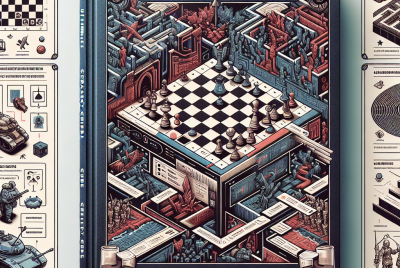Discovering Unique Mechanics in Overlooked Indie Games
Discovering Unique Mechanics in Overlooked Indie Games
Indie games have earned a reputation for pushing the boundaries of creativity and gameplay mechanics in ways that often outshine mainstream titles. While blockbuster games focus on expansive budgets and flashy graphics, indie developers embrace unique mechanics that often emerge from innovative constraints. This exploration highlights several overlooked indie games that showcase exceptional gameplay mechanics, offering fresh experiences to players.
1. “Return of the Obra Dinn” – The Power of Deduction and Investigation
“Return of the Obra Dinn” is a masterpiece of deduction and investigative gameplay. The game builds a unique mechanic around time travel and logical reasoning—players must unravel a maritime mystery by piecing together the fates of the crew aboard a ghost ship. Using a unique graphic style reminiscent of 1-bit art, players are thrust into a captivating atmosphere.
The game’s standout feature is its use of a time-manipulating stopwatch. Players can revisit pivotal moments of the ship’s demise, viewing past events as they occur, and determining the relationships and destinies of the characters involved. The need for users to keep meticulous notes and form hypotheses about events sets “Return of the Obra Dinn” apart from traditional adventure games, where context clues are delivered at a more linear pace. This mechanic encourages critical thinking and enhances player engagement.
2. “Undertale” – The Art of Choice and Consequence
“Undertale” may not be completely overlooked but is often underrated for its mechanics that diverge from conventional RPG gameplay. It allows players to choose between battling and conversing with monsters, introducing a morality-based system that influences the gameplay experience.
Instead of adhering to the classic RPG paradigm of violence, “Undertale” challenges players to explore a pacifist route. Players can spare, compliment, or even flirt with enemies, making real-time choices during battles. This choice-driven mechanic not only affects combat but also changes the game’s narrative, leading to different endings based on player actions. The emotional weight of these mechanics contributes to a deep connection with the characters and the unfolding story.
3. “Baba Is You” – The Logic of Reconfiguration
“Baba Is You” introduces an innovative gameplay mechanic through its unique manipulation of rules. The simplest way to describe its mechanics is that players can modify the rules of the game in real-time, allowing for a profound exploration of logic and strategy.
Each puzzle consists of word blocks that represent game mechanics, such as “Baba Is You” or “Wall Is Stop.” By moving these blocks around, players can reinterpret the rules of the game, leading to creative and often unexpected solutions. This level of gameplay flexibility grants players an unprecedented sense of agency, fulfilling the desire to think outside conventional boundaries. The progressive difficulty ensures that players develop new strategies as they advance through the game.
4. “Stardew Valley” – The Rhythm of Life Simulation
“Stardew Valley” stands as a compelling life simulation game, which innovatively combines farming mechanics with personal relationships and community development. The game’s robust mechanics center around resource management and seasonal changes, creating a rhythm that mimics real life.
What differentiates “Stardew Valley” from similar titles is its seamless integration of farming, mining, crafting, and social interaction. Players are not merely planting crops but engage in a cycle that involves enhancing relationships with NPC villagers, which can unlock new storylines and contribute to a thriving town. The game’s seasonal mechanics affect what crops can be grown and how activities are scheduled, giving an immersive experience that reflects the complexities of rural life.
5. “A Short Hike” – Exploration and Serendipitous Discovery
“A Short Hike” promotes exploration and discovery using a relaxed and charming gameplay mechanic. The game allows players to roam freely across a vibrant island, climbing mountains, exploring new terrains, and encountering diverse wildlife.
Players explore at their own pace, often uncovering mini-puzzles or collectibles that enrich the narrative. The mechanic of gliding allows players to soar through the air, adding a layer of mobility that invites experimentation. The informal structure of “A Short Hike” emphasizes the joy of discovery, encouraging players to explore the environment without fear of losing progress—a refreshing contrast to games laden with structured objectives.
6. “Celeste” – Precision Platforming with a Narrative Heart
In “Celeste,” the mechanics of precision platforming are tied intricately to its narrative of overcoming challenges, both in-game and emotionally. The game introduces a simple yet effective control scheme, focusing on jumping, climbing, and dashing. Each level is meticulously designed to challenge players in a way that feels both punishing and rewarding.
What sets “Celeste” apart is its integration of the protagonist’s mental struggles into the gameplay. Dashing represents not just a mechanic but also a metaphor for personal growth and overcoming obstacles. The narrative of self-discovery intertwines with gameplay, making every victory feel earned. This unity of mechanics and story elevates the platforming genre, making it more than just a test of skill.
7. “Dead Cells” – The Dynamism of Rogue-like Combat
“Dead Cells” combines rogue-like elements with metroidvania mechanics, creating a fast-paced action experience that emphasizes skillful combat and exploration. The game’s use of procedurally generated levels ensures that no two runs are the same. Players face unique challenges, with a plethora of weapons, and can create their own combat style on each run.
A unique mechanic within “Dead Cells” is the combo system that encourages players to string together attacks for increased damage. The fast-paced nature of combat, combined with the thrill of discovering new abilities and upgrades, keeps the gameplay dynamic and engaging. This sense of progression is compounded by a permadeath system that adds stakes, rewarding mastery and fluency in combat rather than mere chance.
8. “Hollow Knight” – The Depth of Exploration and Lore
“Hollow Knight” offers players a rich, expansive world marked by intricate lore and rewarding exploration. The game blends metroidvania platforming with deep storytelling, providing a unique mechanic of drawn-out map exploration. It emphasizes the importance of uncovering the history of Hallownest—a decaying kingdom filled with secrets.
The combat caters to players who enjoy finesse and precision, with various abilities that evolve as players progress. Mechanics such as collecting “Geo” to purchase upgrades or unlocking new abilities by defeating various foes drive engagement. Each decision impacts the world around them, and players are motivated to dive deeper, uncovering layers of lore and unlocking unique abilities as they navigate a visually striking, interconnected world.
9. “Ni No Kuni II: Revenant Kingdom” – Kingdom Building and Dynamic Combat
While more well-known than other indie titles, “Ni No Kuni II” features unique mechanics that enrich its gameplay experience. The integration of kingdom-building strategies with action RPG elements creates a refreshing dynamic.
Players must manage resources, recruit citizens, and make decisions on kingdom policies, which can have a tangible impact on gameplay and events. This combination of combat and simulation mechanics requires players to develop different skills, from strategic thinking to real-time battle tactics. The overworld exploration ties this mechanic together, leading to an immersive experience where players can see the direct impact of their choices reflected in their kingdom’s prosperity.
10. “Oxenfree” – Dialogue Trees with Time Manipulation
“Oxenfree” augments its narrative depth with a unique dialogue mechanic that allows players to influence conversations fluidly. Players can choose responses during conversations that change the flow of the narrative and the relationships between characters.
A standout element is the time manipulation that plays a vital role in the story, woven into the gameplay mechanic. The interactions with the environment, intertwined with character development, heighten the emotional connection to the story. The atmospheric visuals combined with innovative dialogue options create a deeply engaging and thought-provoking experience.
Engaging with Unique Mechanics in Souls of Indie Titles
The indie gaming scene continues to thrive, offering an array of overlooked gems filled with innovative mechanics. These games exemplify the potential of independent development, where constraints encourage creativity rather than stifle it. By focusing on unique gameplay experiences, these titles not only redefine game mechanics but also remind players of the rich tapestry of storytelling and immersion that gaming can offer. Engaging with these games allows players to discover unfiltered imagination and the endless possibilities that lie within the digital realm.




